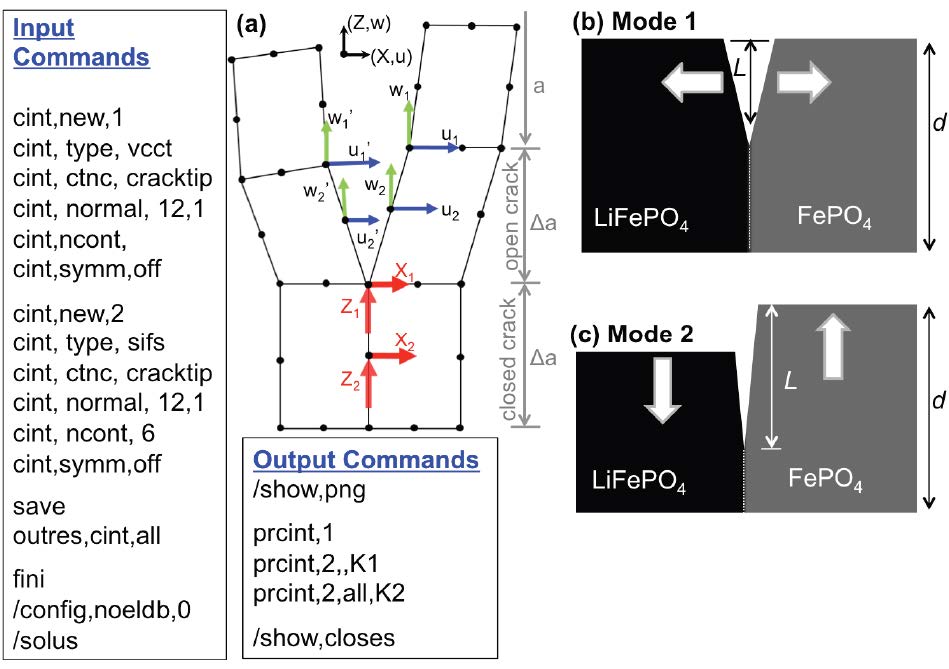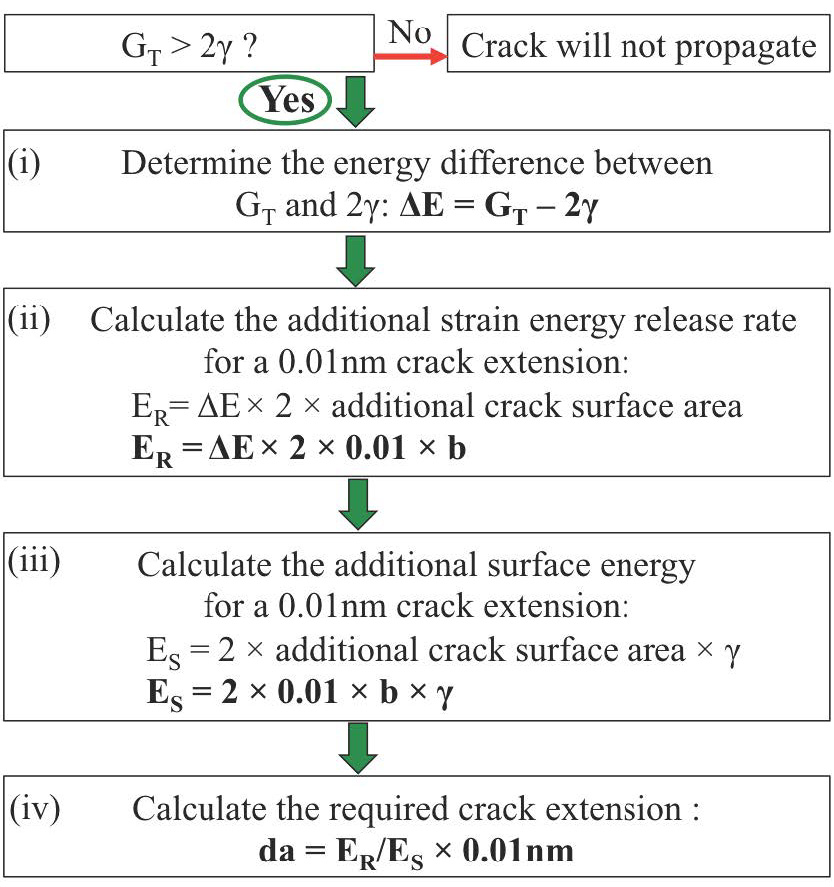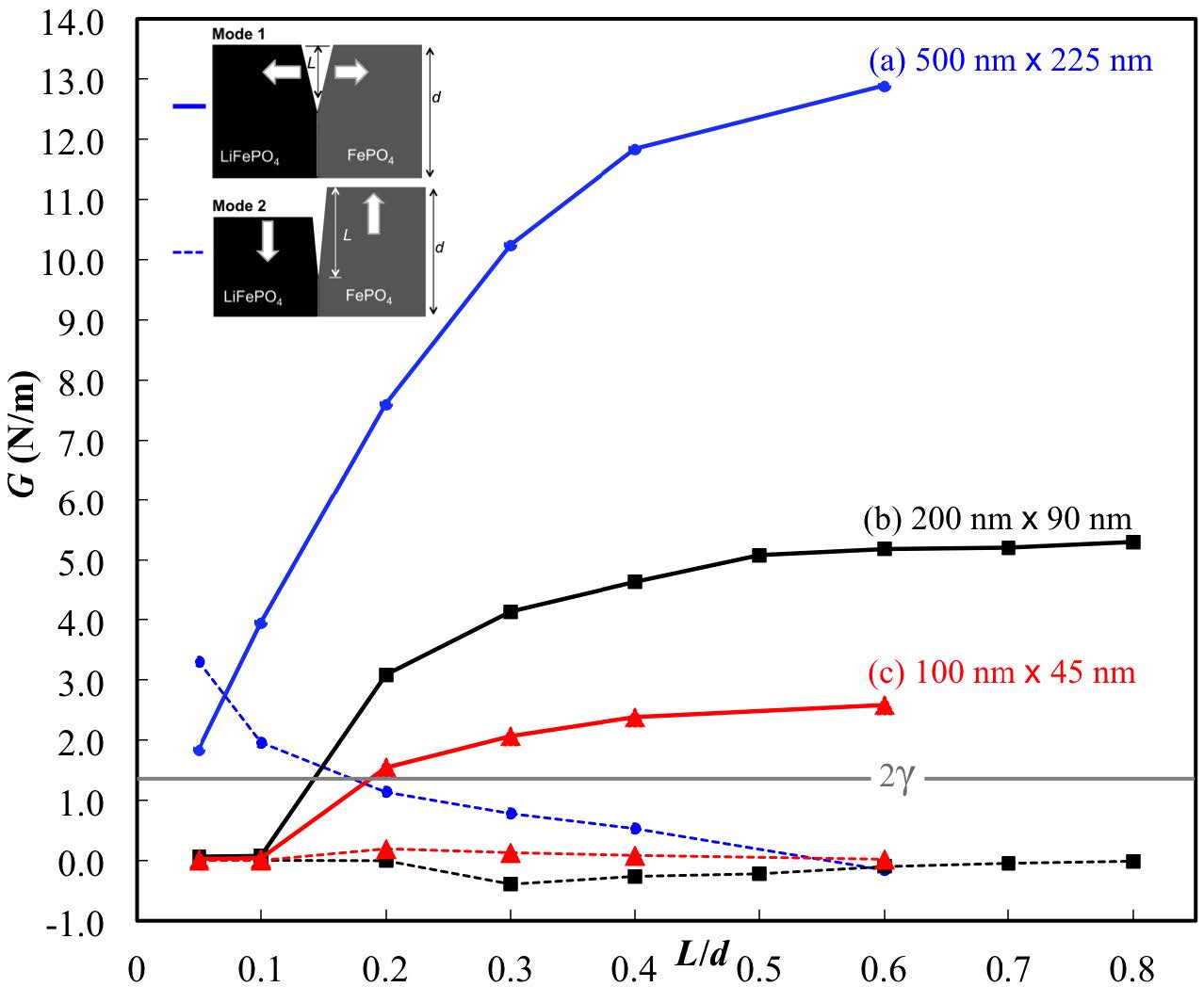Lithium-ion batteries have become a widely-used commodity for satisfying the world’s mobile power needs. However, the mechanical degradation of lithium-ion batteries initiated by micro cracks is considered to be a bottleneck for advancing the current technology. This study utilizes a finite element method-based virtual crack closure technique to obtain particle- and crack-size-dependent estimates of mixed-mode energy release rates and stress intensity factors. Interfacial cracks in orthotropic bi-materials are considered in the current study, whereas the crack extension along the interface is assumed. The results show that energy release rate, stress intensity factor, and the propensity of crack extension are particle- and crack-size- dependent. In particular, our results show that for smaller plate-like LiFePO4 particles (100 nm × 45 nm), a crack has lesser tendency to extend if crack-to-particle size is less than 0.2, and for 200 nm × 90 nm particles, similar results are obtained for crack-to-particle sizes of less than 0.15. However, for larger particles (500 nm × 225 nm), it requires an almost flawless particle to have no crack extension. Therefore, the current study provides insight into the fracture mechanics of LiFePO4 and the associated crack-to-particle size dependency to prevent crack extensions.
1.
Introduction
Production and trade of dried aromatic herbs have increased in the last quarter century and these compounds are currently present in almost all kinds of food preparation where they intensify flavor, aroma and color or provide a distinct sensorial characteristic [1]. Consumption of these commodities has also significantly increased in the last decade mainly due to a global trend for ethnic and regional cuisines where dry herbs enhance the particular characteristics of typical dishes, such as for example basil and oregano in Italian and Greek culinary [2]. In the Mediterranean countries they play an important role in the traditional diet and apart from being used as seasoning condiments they have been recognized as a valuable source of high value nutritional compounds such as antioxidants and essential oils [3].
Similar to other food products from agricultural origins dried aromatic herbs can be naturally exposed to microbial contamination during any stage of production since pre-harvesting to harvesting, processing, distribution, storage and use by consumers [4]. The dried herbs production chain is vulnerable to accidental or natural microbial contamination whose origin is hard to determine. Although present in food products only in minor quantities these ingredients can be carriers of pathogenic microorganisms and of some toxin and spore producers. Currently an increasing number of studies have demonstrated the ability of some foodborne pathogens such as Salmonella spp., Escherichia coli 0157:H7, Cronobacter sakazaki, Staphylococcus aureus to survive and grow in some aromatic dried herbs [5,6]. Recently new research showed the presence of Bacillus cereus in ten different aromatic dried herbs commercialized in Poland [7]. When these products are rehydrated and subjected to a favorable temperature range those microorganisms may find the ideal conditions to multiply and cause a foodborne infection or intoxication. In addition, pathogens which survive and grow in low moisture foods can acquire a virulence profile such as an increased thermal resistance, a higher tolerance to antimicrobials and a reduced infectious dose [5]. The safety risk is even higher considering those commodities are usually added directly to ready-to-eat foods/meals which do not require any heat treatment before consumption. Herbs and spices are the main source of spore-forming bacteria in products such as soups, cooked or stewed dishes and sauces [8]. These foodborne pathogens are also known for their capacity to survive and grow in desiccation conditions and persist in food processing environments. Foods from non-animal origin such as dried herbs along with spices, fruits, vegetables, seeds, nuts and cereals are recognized as critical hazards and have been associated with large outbreaks such as the 2011 VTEC (verotoxin-producing Escherichia coli) outbreak in Germany which cause 3793 cases, 2353 hospitalizations and 53 deaths [9]. According to the European Rapid Alert System for Foods and Feeds [10] the dried herbs and spices food category had one of the highest numbers of recalls and outbreak notifications in the recent years. Since 2013 more than 500 notifications have been associated with Salmonella spp. present in dried herbs and spices [11]. Therefore, most of the food recalls refer to processed foods which did not experience any lethal procedure such as thermal, chemical or radiation treatment.
Currently data on the microbiological quality of these products are scarce and not available. On the other hand, the drying process of herbs leads to a stable product which can attend the consumer's demand during the whole year. Therefore, the consumer's assumption on the innate safety of low-moisture food products such as aromatic dried herbs may rise the opportunity for the occurrence of cross contamination. In fact, little is known about the potential impact of dried herbs on the survival, growth and tenacity of foodborne pathogenic microorganisms at this kind of food matrix. Currently legal regulations in the European Union still do not include microbiological criteria for these commodities but the European Commission (EC/2004) [12] refer that food products should be free of pathogenic bacteria which may represent a public health risk for the consumer. This recommendation states that Salmonella, should be absent in 25 g of a dried herb sample, Escherichia coli and Bacillus cereus should be present at less than 102 CFU/g and the total count of mesophilic bacteria should be acceptable between 102 and 104 CFU/ g of product. The contamination of dried herbs by yeasts and molds represents also a food safety hazard; some of those microorganisms may produce toxins originated from improper harvesting and storage. Some of these mycotoxins may cause adverse effects on human and animal health due to their neurotoxicity and the risk of being potentially carcinogenic and/or teratogenic [13].
Although dried herbs are present as minor ingredients in food/meal composition they can potentially contaminate a wide range of products. Therefore, the maintenance of a good microbial quality of dried herbs is crucial for avoiding the presence of these pathogens in food supply chain and reducing the public health concerns and hazards associated with their potential risks. Since food safety is one of the greatest concerns regarding these commodities the aim of this study was to evaluate the microbial quality at the point-of-sale of a group of eight types of dehydrated aromatic herbs commercialized at retail shops in the region of Algarve (Southern Portugal) and to assess their compliance to the current food safety standards.
2.
Materials and methods
2.1. Sampling and sampling preparation
The commercialized dried aromatic herbs were purchased in individual packs of 8 g to 40 g from retail shops within the region of Algarve (Southern Portugal) and were subjected to examination before their use to date. They were transported to the laboratory in a cold box (bellow 4 ℃) and analyzed immediately. In total the experimental material included 99 samples composed of eight different dried aromatic herbs (basil: 13; bay leaves: 12; coriander: 9; oregano: 16; parsley: 14; Provence herbs: 10; rosemary: 10; and thyme: 15). These samples were purchased from different companies and distinct brands and batches.
2.2. Microbiological analyses
The samples were determined for: Total count of aerobic mesophilic bacteria, total count of molds, Escherichia coli, Salmonella spp. and coagulase positive staphylococci. The assays were performed according to the ISO International Standards methods and the microbiological status of the dried aromatic herbs was assessed using the criteria outlined in Recommendation 2004/24/EC (European Commission (EC) 2004a and 2004b). The herb samples were submitted to decimal dilutions and aliquots were inoculated in the culture media proposed by the ISO International Standards. The aerobic mesophilic counts were performed according to the ISO 4833 (2003) and aliquots were pour-plated in Plate Count Agar and incubated at 30 ℃. The molds were enumerated following the ISO 21527-1(2008), spreading the aliquots on Dichloran Rose Bengal Chloramphenicol Agar following incubation at 25 ℃. Escherichia coli β-glucuronidase positive was counted through the ISO 16649-2 (2001) using Tryptone Bile X-Glucuronide at 44 ℃; the number of the coagulase positive staphylococci was determined according to the ISO 6888-1 (1999; Amd 1:2003) using Baird-Parker media followed by incubation at 37 ℃ and Salmonella sp. was detected according to the ISO 6579 (2002). For each sample, all the analyses were performed in duplicated.
3.
Results and discussion
The hygienic quality of 99 samples of dehydrated aromatic herbs purchased in retail stores in Southern Portugal was assessed and the achieved results are summarized in Tables in 1 and 2. The mesophilic total counts ranged from under the detection limit to 1.2 × 107 cfu/g and 47% of the samples did not exceed the 104 cfu/g level (Table 1).
The lowest mesophilic microorganism counts were found on coriander and parsley (7.4 × 104, 3.2 × 104 cfu/g) whereas the highest microbial counts (1.6 × 106, 6.4 × 105 and 4.2 × 105 cfu/g) were associated to basil, thyme and provence herbs respectively. Basil and thyme were the only herbs with higher counts than 6 Log cfu/g which represents only 11.1% of the samples. In case of bay leaves, oregano, province herbs and rosemary, just one sample of each exceeded 106 cfu/g, the limit value according to the International Comission on Microbiological Specifications for Foods above which the samples are classified as having unsatisfactory microbiological quality [14] (ICMSF, 1974). Other studies found the highest mesophilic microorganisms' counts in oregano, tarragon and basil [6] or in rosemary and and bay leaf [15]. The diversity of results might be explained by the crop production, harvesting, storage conditions, and a complex distribution network of the herbs, which differ in each geographic region.
The mesophilic counts are considered a useful microbiological indicator of the initial quality of raw materials and whether good practices of manufacturing have been performed [16]. Therefore, the production and processing of herbs deal with several critical steps to ensure safe handling procedures and prevent microbial contamination. In fact, herbs are in general added to foods without further cooking or processing and their microbial quality is of major importance to avoid spoilage and safety hazards.
In general, significant differences in results obtained by different sources may be addressed to diverse factors. Some aromatic dried herbs are rich sources of phenolic compounds and essential oils whose antimicrobial properties have been demonstrated by a large number of studies [17,18,19]. This might have an inhibitory effect on the survival and proliferation of the microbiota.
Concerning the filamentous fungi (Table 2) their counts were lower than the levels of mesophilic populations, ranging from under the detection limit to 2.6 × 105 cfu/g. None of the samples showed higher counts than 6 Log cfu/g which is the limit above which some countries microbiological guidelines classify as unacceptable (Critéres microbiologiques des déenres alimentaires, Luxembourg, 2007). In 32.3% of the samples the level of filamentous fungi was inferior to 10 cfu/g (under the detection limit of the method). Parsley and coriander were the herbs with the lowest molds media counts (1.1 × 102 and 6.9 × 102, respectively) and bay leaves, thyme and rosemary, presented the highest counts (2.3 × 104, 2.0 × 104 and 1.6 × 104 cfu/g, respectively). The ocurrence of molds in herbs, partitally favoured by the climatic conditions (high temperature and humidity) of production areas can affect food quality and safety, as some species produce mycotoxins [13,16] and can potentially cause food poisoning. On the other hand molds may change the appearance, flavor and texture of the foods where they grow on affecting their organoleptic properties.
The analysis of the overall results obtained in the present study reveals an average good microbiological quality of the herbs and the majority of samples were of sactisfactory or acceptable microbiological quality according to the Recommendation 2004/24/EC (European Comission (EC) 2004a).
No pathogens such as Salmonella spp., a food safety parameter at the marketplace and Escherichia coli, a food hygiene parameter [20,21] (EC, 2005; EC 2007), were detected in any of the herbs. According to increasing data based on [22,23] and on EU summary reports between 2004 and 2014 the presence of Salmonella spp. has been detected in several kinds of dried herbs. Salmonella–related outbreaks where herbs were the principal foodborne source have also been reported [24]. In fact 23% of herbs and spices RASFF reports, between 2004 and 2014, were associated to pathogenic microrganisms among which Salmonella spp. corresponded to 74%. Given the high ability of this pathogen to survive in low–moisture environments for long periods and persist in food processing facilities Salmonella has had the highest number of RASFF notifications associated to the dried herbs category [8]. The contamination of dried herbs by Escherichia coli, referred by [23,24] and associated to a 12% frequency of RASSF reports in the same period, was not observed in any of the present samples indicating an acceptable hygiene quality of the analyzed herbs. On the other hand, pathogens such as Staphylococcous aureus, a toxigenic member of the coagulase positive staphylococci group and a microorganism associated to improper food handling, according to [15,25] has also been isolated from dried herbs. The absence of this microrganism at the present assay may reinforce the sactisfactory microbiological quality of these products. However, the antimicrobial effect of dried herbs against pathogens such as rosemary, oregano and thyme on Salmonella spp., Escherichia coli and Staphyloccocus aureus has been well documented [17,26,27,28,29,30] and further investigation may be needed in order to clarify the real meaning of negative results in pathogens screening tests.
4.
Conclusions
Dried aromatic herbs like any other low–moisture food, which once were considered microbiologically safe, have shown in recent years to be vehicles of foodborne pathogens implicated in disease outbreaks and recalls. The implementation of good hygienic practices along the whole supply chain, besides the application of validated lethal process before distribution at retail is fundamental to ensure their food safety standards.
The present study sheds some light on the importance of monitoring and keeping the surveillance of dried aromatic herbs supply chain but also raises several questions to address in future research such as the role of food matrix as the substrate for microbial growth as well as the inhibitory effects they might have on their transmission and virulence.
Further research is required to elucidate the interactions between natural antimicrobial compounds of dried herbs and the food matrix and also the possible extension of the inhibitory effects. This might be important to gain a real insight of microbial level of contaminations in dried herbs and preventing the under estimation of microbe viable counts. More data should be obtained in order to evaluate the microbiological quality of dried herbs used in dairy and meat industry as well as in ready-to-eat-foods at commercial and home level.
Acknowledgments
This study received Portuguese national funds from FCT-Foundation for Science and Technology through project UID/BIA/04325/2019 (Center for Mediterranean Bioresources and Food, MeditBio).
Conflict of interest
All authors declare no conflict of interest.









 DownLoad:
DownLoad:








